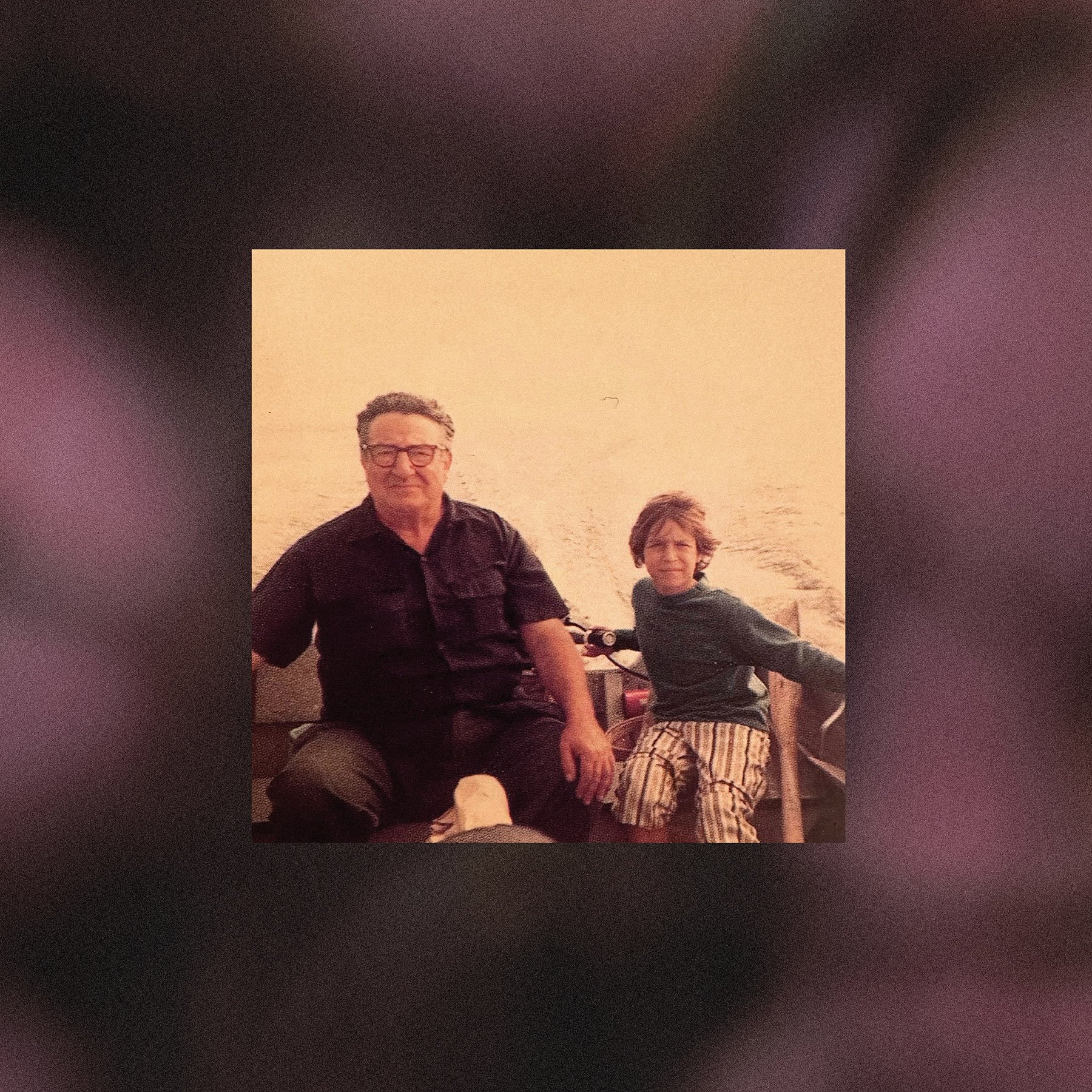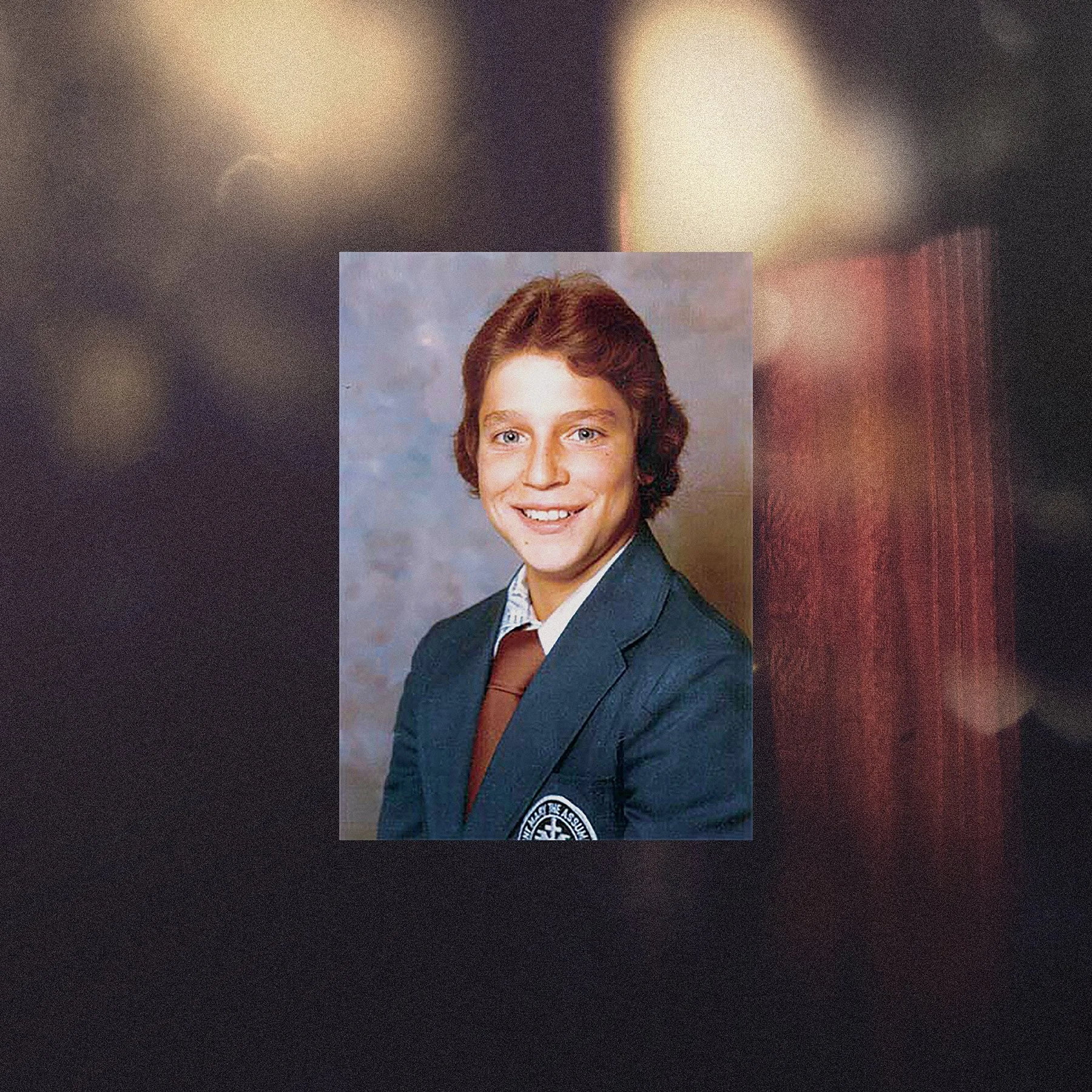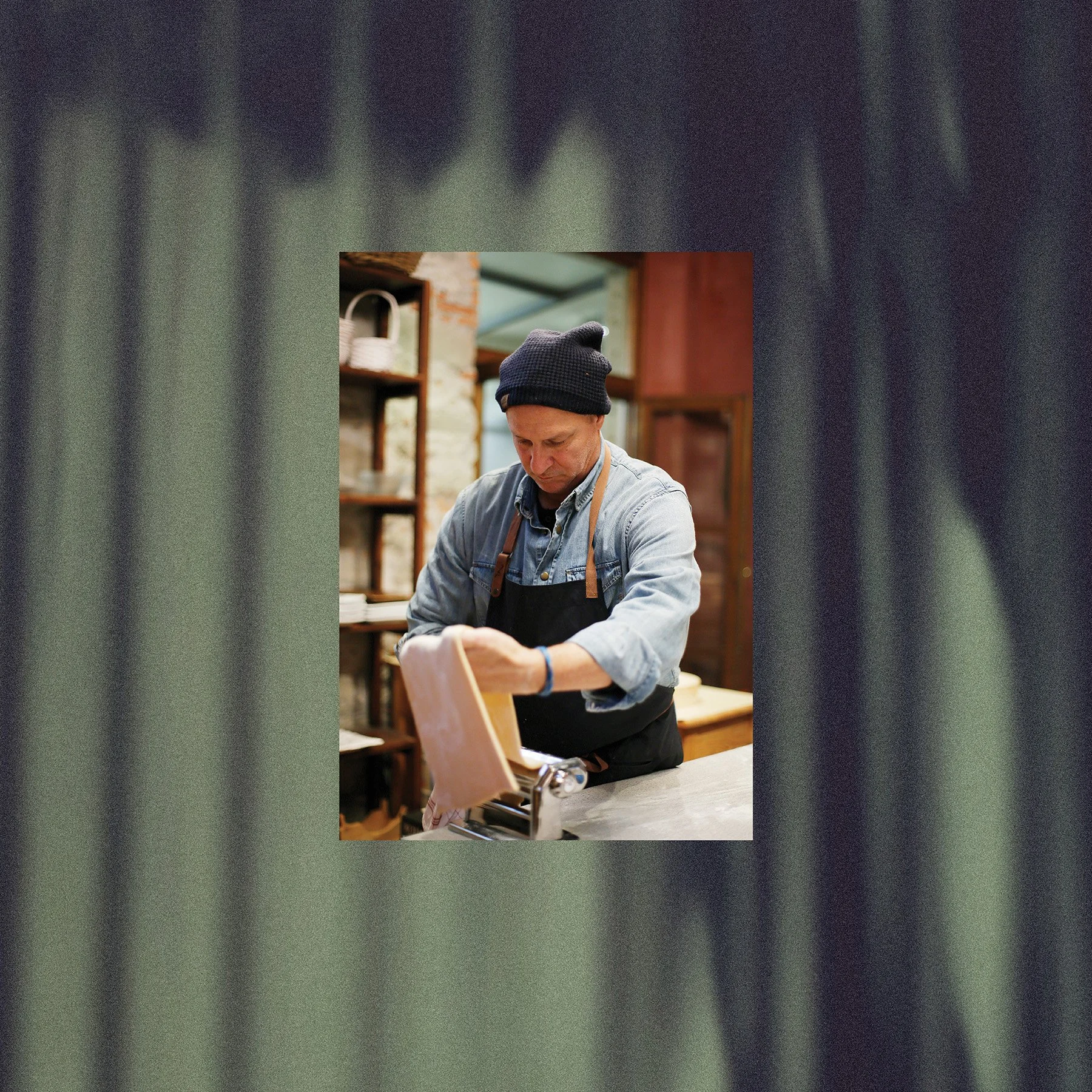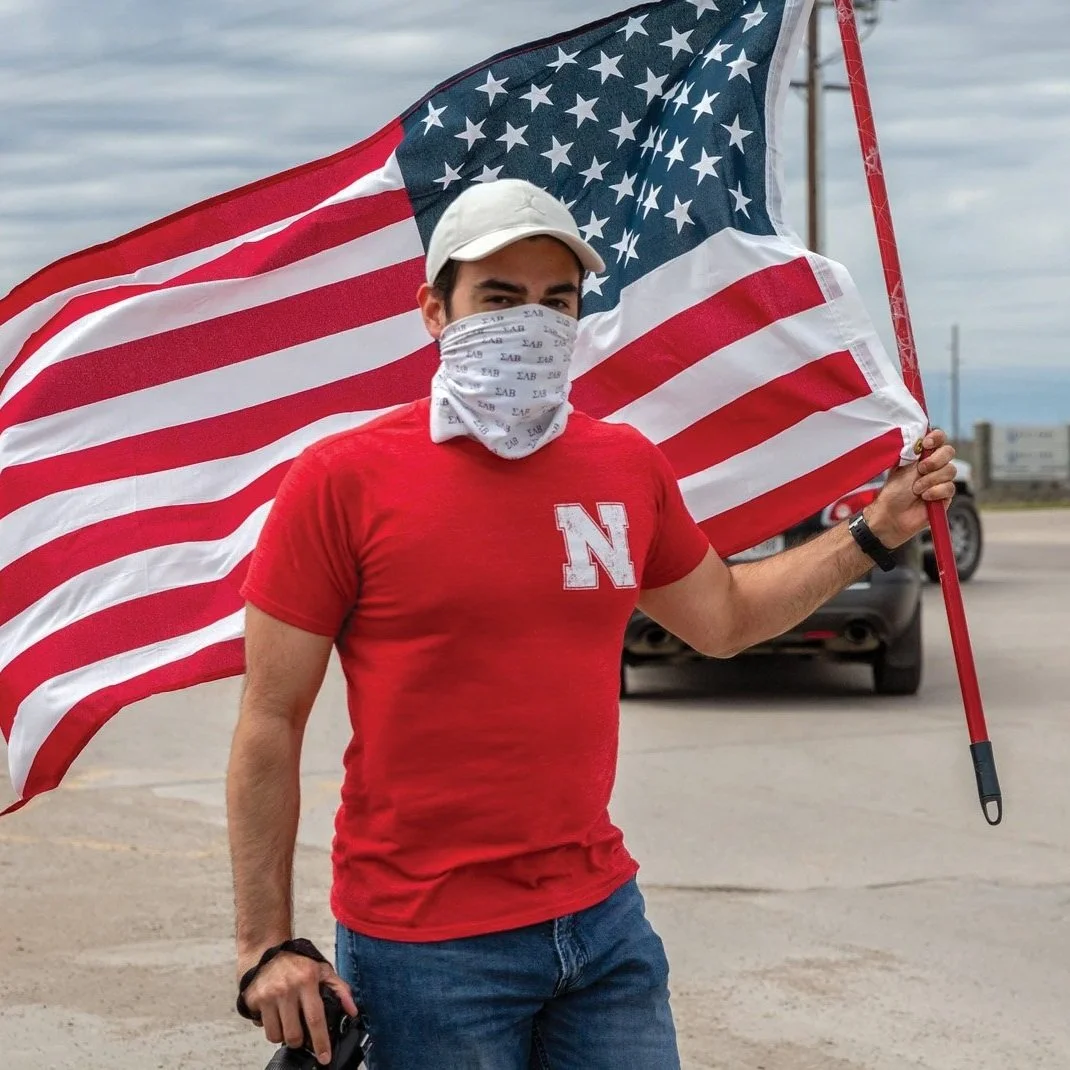A Chef’s Journey
Essay by Tom Colicchio
Produced in partnership with the Food & Environment Reporting Network
1.
Three o’clock in the morning, I’d wake to the smell of peppers and onions frying, my grandfather in the kitchen. Then the sound of sizzling, him adding eggs for the sandwiches we’d eat later when we were out on the water.
I grew up in a four-family redbrick apartment building in the Italian section of Elizabeth, New Jersey, where I shared a bedroom with my two brothers. We each had a bed and drew imaginary lines to mark off our turf, my side from theirs, no crossing. But on Saturdays when I went fishing with my grandfather, who lived in the apartment behind ours, I’d always sleep over the night before. He’d get up before I did and get the peppers and onions going, that smell rousing me from sleep.
My grandfather—my mother’s father, Michael—was retired, so he was always around, very present. He’d spend all week in his basement tinkering or outside gardening. We didn’t have land, so he was just growing in five-gallon buckets—tomatoes, zucchini, eggplants, some peppers. We didn’t have much, but good food made from fresh ingredients was important to our family.
And my grandfather had a small boat in Barnegat Bay, near the mouth of Toms River. On those dark Saturday mornings, we’d go out crabbing on the shoals of the bay, clamming on the flats. He always had a fishing line in the water, and sometimes he’d get a bite—weakfish, bluefish, eels—but he wasn’t a very good fisherman. I got my first lessons in patience from fishing on his boat, the patience of persistence and coming up empty. Instead, we’d usually just come home with two bushels of crabs and a bushel of clams.
Once we had our day’s catch, I had two important jobs.
One was keeping my grandfather awake on the ride home. Looking back on it, it’s hard to believe, but this was the late ’60s. I was maybe five years old, sitting in the front seat—no seatbelt, I’m sure—and it was my responsibility to keep an eye on him, to make sure he didn’t veer from the road. If I caught him nodding off, I would nudge him. He would always straighten in his seat, clear his throat. “I’m not sleeping,” he’d always say. “I’m just resting my eyes.”
My other job, once we made it home (and somehow we always did), was to go into the basement and clean whatever we caught. I’d wash the clams and crab, gut and filet the fish. Then I would bring it all upstairs, and my mother and grandmother would cook. They would steam the crab, but then they would take the shell off, take out the gills, and cook that in a marinara sauce. We called it crab gravy. And then we would ladle that over linguine. The crabs were usually just steamed with garlic and olive oil, some white wine and herbs. The fish, if we caught any, was always fried.
We had a ton of food, and this wasn’t just a meal for my immediate family. My mom’s parents would join us, of course, but I also had an aunt upstairs in the back, more friends and family in adjoining buildings. It was always twenty people crowded into our tiny dining room.
And this was a long meal. First the pasta. After you eat your linguine with crab gravy, then you’re picking crab. And you’re picking for a couple hours. The conversations would always start with the day—excuses for the poor fishing, the big fish that got away—and then it would go to sports and neighborhood gossip and politics. In my family, we were all on the same page about politics, so there were no arguments. It was just loud, boisterous conversation.
From a very young age, I saw how food brought people around the table.
My father, Thomas, had a barbershop, but he was also a gambler. When I was growing up, you could tell how my father was doing by what was on our table. If he had a winning week, we had steak—a big London broil for my mother to bake. If he was losing, we’d be eating with my grandparents, having sandwiches and soup. One day, my dad came home and the barbershop was sold. He lost it gambling. He became a corrections officer at the Union County Jail, and eventually, he was elected the head of the local union. We didn’t have a lot of money, so we ate in almost all the time. My mother, Beverly, was a stay-at-home mom, and she cooked most of the meals. She made a lot of Italian staples: chicken marsala; this stew of steak with peppers, onions, mushrooms, and a little sherry; pork chops with cherry peppers, onions, and vinegar. Meals weren’t fancy, but flavor was important.
I was always drawn to cooking myself. There was a technical side to it that I found at a very young age I was good at. It came very easily to me, which wasn’t the case with everything. I struggled in school. Today, they would have diagnosed me with ADHD, but back then, I was just considered a troublemaker. I got kicked out of St. Mary of the Assumption High School more than once. One day when I was 13, I was being punished for misbehaving at school and had to go with my mother to my cousin Patty’s beauty salon. As I sat there, I was looking through all the magazines—Car & Driver, the gossip rags—and then I picked up one called Cuisine. I thought, “Wow, what’s this?”
“The most important lesson: Lots of recipes simply don’t work.”
The cover story was about Creole and Cajun cooking. Inside, the feature discussed the history of this food, originating with the French Canadians from Arcadia and then coming down the coast where it was transformed by slaves and former slaves, and it included some recipes from New Orleans. One of them was this baked stuffed eggplant, called a pirogue. I tore out the recipe and decided to make it for my family. I froze the eggplant, hollowed out, and then stuffed it with this mixture of onion, celery, a little tomato, the eggplant that I’d scooped out, some zucchini, and shrimp. I put cheese over the top and broiled it. Only when I took it out of the oven and was actually serving my family did I realize: it was just an appetizer. Without a word, my mother got up to make dinner to save me from the embarrassment.
But my father seemed to sense that food was my destiny. That summer, he got me a job at the snack shack at the Gran Centurions Swim Club, in Clark, New Jersey, where my parents were members. I started with scooping ice cream and working the register but soon took over grill duties. I flipped burgers in shorts and flip-flops—the best job I ever had. It’s also where I learned why salt is important. When I added it to a steak, everything changed. Seeing my enthusiasm, my dad brought a bunch of books home from the library at work, including Jacques Pépin’s La Technique. The book was brand new then—I have no idea what it was doing at a county jail library—but there it was, and it changed my life.
The most important lesson: Lots of recipes simply don’t work. The chef gives you a long list of ingredients and pages of step-by-step instructions, but what if you don’t have a crucial ingredient or you don’t have the right pot or pan? Instead of following recipes, Pépin argued for developing a basic set of techniques to master—how to make a stock, how to skim it, how to make consommé by creating an egg white raft to clarify the stock. Mastering these techniques, one by one, unlocked something in my brain. I thought, “Wow, all that text in those magazines that I’ve been trying to get through, all they’re teaching me is how to braise a lamb shoulder?” Well, now I know how to do that—and now that I can braise a lamb shoulder, I can probably braise anything. It’s all the same technique.
This structural understanding allows the cook to use preparations like building blocks; instead of just following recipes, you learn how a dish is built and that allows you to imagine how you could create new dishes. You learn what flavors emerge from certain techniques, what ingredients you can combine with those flavors, which spices and herbs pair with and highlight those ingredients. Once you learned the basic techniques that Pépin set out in his book, you could forget about recipes and really become a cook. In fact, in the last paragraph of the preface, Pépin wrote: “Remember, you are not learning new recipes, you are acquiring a new way of cooking; you are going into apprenticeship.” I took that to heart.
The change didn’t happen overnight—I got kicked out of St. Mary’s again after my junior year—but now I knew where I was headed, and that settled me down a little bit. Under my picture in the yearbook, Elizabeth High School graduating class of 1980, it says: “Plans to be a chef.”
2.
After graduation, I couldn’t see myself going to college, but one of my father’s friends, who did refrigeration and air conditioning for restaurants, told me about this cooking school called the Culinary Institute of America in Hyde Park, about two hours north of New York City. If I really wanted to be a chef, he said, maybe I should look into that. I drove up to the campus and got some brochures and application materials. The main takeaway: before the school would even consider me for entrance, I had to have at least two years’ experience in at least two different restaurants. I was determined to put my head down and get to work.
My father’s friend got me a job at Evelyn’s Seafood Restaurant in Elizabeth. It was a big place that mostly made broiled and fried fish platters, nothing fancy, but it was a local institution, a great spot to learn the pace of restaurant work. When they first put me on the line, I was stationed in an area called the bench, pulling tickets and getting the orders going. Plus, I’d open clams and oysters. Thanks to my grandfather, I was pretty good at opening clams, but I wasn’t fast enough. We would do a thousand covers on a Saturday night, and I just couldn’t keep up. I was missing orders and falling behind on the clams. I lasted that first weekend, before they sent me downstairs to the prep kitchen.
My first day down there, my boss pulled out 150 pounds of shrimp and said, “Peel.” These shrimp were 10-12 per pound, not very big, so it took me hours. And when I was done, they put another 100 pounds in front of me. I wanted to cry, but I went back to peeling. Somewhere near ten o’clock that night, I literally fell asleep still standing up, just slumped over the bowl of shrimp. One of the servers came down and poked me. When I straightened up, everybody was laughing. Turns out, this was supposed to be a job for eight guys in the kitchen. They gave me the task as a kind of test, like, “Here you go, rookie, see how you handle this.” And I guess I passed.
After that the head cook, an older Black man named Slim, took me under his wing. He made all the dishes that required any real cooking—Thermidor sauce for the lobster, the crab-meat stuffing. I watched his every move, learning how to taste as you go, adjusting according to what flavors the ingredients were giving you that day. Here I was a 17-year-old kid, getting a chance to try my hand at everything from prep to pastry to line cook and working with a lot of college waitresses and this ragtag group of partying, drug-taking, hard-drinking misfit cooks. I loved it, but I knew my heart wasn’t in this fried and broiled seafood restaurant.
I’d go around telling the rest of the kitchen staff, “I’m going to be a chef one day.” So when we had a slow afternoon, this woman who worked at the breading station, asked, “What kind of stuff are you talking about?” I made her this dish—a sautéed fluke with crab on top and asparagus and a beurre blanc. She tasted it and was like, “Wow, this is really good.” And I remember how happy that made me, and all of the ingredients were right there in that kitchen. “This is what I’m talking about,” I told her, “I want to do this.”
So I moved on from Evelyn’s to the Chestnut Tavern, a family-owned red sauce Italian restaurant. The kitchen staff was an even bigger bunch of misfits, everyone slacking off, but I was eager to learn, so the morning sous chef kept giving me more responsibility. I relished the extra work. I even learned to butcher by watching the guy who came in every Wednesday to break down six veals for the week, plus steaks and chicken. I’d get my job done quickly and then I’d watch him work, studying the way he held his knife, the movement of his cuts, asking a few questions but mostly just observing.
At the same time, I was reading everything I could possibly read—every magazine, every book. I’d moved on from Pépin’s La Technique to La Méthode, which focused heavily on knife skills, from how to hold your knife to julienning vegetables to filleting fish. I was buying heads of celery for 39 cents just to practice my fine chopping for mirepoix. And through the magazines, I was following everything that was going on in Europe. I knew who the chefs were and the kind of food they were making. I could look at a bunch of photos and say, “Yeah, that’s Jean and Pierre Troisgros. That’s Paul Bocuse. That’s Alain Chapel.” I just knew because I was studying the way they cooked, the way they plated and presented their dishes.
“If you’re not ready, you’re never going to get another chance.”
About that time, I saw an ad for a new restaurant in Millburn, New Jersey, seeking kitchen help to cook “the New American Cuisine.” I was curious. I took my girlfriend there to 40 Main Street to see what they were doing. The menu was unlike anything I’d seen before; it was simple but creative, with an emphasis on fresh ingredients. I applied for the sous chef position, but it was already filled, so I took a cook job. The chef, Jim Smith, would come in every day, and he’d sit down with the sous chef, Jerry Bryan, and with me and the other cooks, and we would come up with an original menu. Jim would say, “Today, I have wild mushrooms and some pheasants and quail,” and we would create a dish. Then he would give us more ingredients, and we would build a whole menu that way. So I started to learn the creative process and after we received three stars in the New York Times, I discovered what it was like to cook in a popular restaurant with all eyes on you.
By then, I had moved out of my parents’ house and moved in with my girlfriend. She was going to Montclair State, so we got an apartment in East Orange, which was even rougher than Elizabeth—and Elizabeth was pretty rough. It was close enough to New York that the city seemed to beckon. Growing up, I had seen the skyline in the distance, the Twin Towers shining at night, and we would go there on class trips to museums every now and then. But New York was New York. I always thought: you go to New York, you have one shot—and if you’re not ready, you’re never going to get another chance. But now, we were so close that we could go to the city on weekends, and I had friends who worked in restaurants there. They convinced me that I was ready, so I decided: I was going to go to New York.
3.
I shopped my résumé around and soon got a call from Barry Wine, the chef-owner of the Quilted Giraffe. At the time, the Quilted Giraffe was the place to be: a four-star restaurant with astronomical prices and a celebrity clientele, serving some of the most exciting food that I’d ever seen on a plate. Barry told me straight out, “I don’t hire people like you.” By that, he meant career cooks. He was a former lawyer, and he liked the idea of a kitchen counterculture, filled with writers, artists, and other people like him who had quit jobs on Wall Street or Madison Avenue in order to pursue their love for food. He liked his cooks to be unencumbered by training in traditional kitchens. In fact, Barry had devised a system where everything had to be cooked and plated within ten minutes of when the ticket was fired. He figured you can’t screw anything up in that time, and it worked great for his small, unconventional staff, but he was about to expand, and he wanted to see if career cooks, with more experience, could adapt.
It didn’t take long for Barry to see the advantage of having some trained staff like me. One day, a half-dozen baby lambs that Barry had ordered arrived in the kitchen without warning, all of them dressed but not butchered. The poets and actors in the kitchen didn’t have any idea what to do. Well, I figured we couldn’t serve the lambs whole, so I dove right in. And thanks to the skills I’d picked up at the Chestnut Tavern, I could butcher all six of them, just one after another, while the other cooks stood there, watching me in shocked silence. I guess Barry came around on career cooks, because he promoted me to sous chef after just four months.
Soon after, I got a call from the owner of 40 Main Street who needed help. His chef had left abruptly. I agreed to fill in for a few nights, but then, he suggested that I stay on as executive chef. You might think I’d be reluctant to go back to New Jersey and back to the restaurant that I’d left less than a year before. It’s true that I wanted to be a chef in New York, and now I knew that I could hack it at that level, but I needed time. At that moment, it was no longer enough to make good food in a certain ethnic tradition; great chefs were expected to have an identifiable style, and I welcomed the chance to develop that style away from the limelight of New York. I agreed to take the job on the condition that my old friend Jerry Bryan could come on as co-chef. Running a kitchen with him was great, but I still felt that I was missing something.
I asked a friend to arrange a stage—essentially an on-the-job internship—at l’Hôtel d’France, a Michelin two-star inn and restaurant. The rustic, beautiful countryside of Gascony was unlike anything I’d ever seen in New Jersey, and the ingredients that came through the doors each day were incredible. Ortolans and alouettes, tiny game birds, that we roasted on a skewer with a cépe and a piece of goose liver. Whole foie gras, wild ducks, pheasant. Everything arrived in full plumage for a pair of tough old Portuguese women to pluck. When they were done, I had to singe off the tiny pinfeathers. Once I was even given a giant wild hare with its floppy ears and big feet to butcher. I dimly remembered Jacques Pépin’s instructions on skinning a rabbit, so I grabbed a knife and went at the furry beast.
Every day a vegetable vendor would pull up in a truck piled high with fresh produce from local farms, and the cooks would go out back to choose what we needed for the menu that day. I learned by watching farmers, the vendors, the kitchen staff, even the customers, how all of them had this amazing respect for food. I suspect this was a legacy of World War II and the years after, when food was scarce and everyone learned not to waste anything. The way the food was cultivated and handled, its treatment in the kitchen, the way it was savored and shared at the table, was a revelation to me. I also learned that it was far better to offer a few dishes made of the freshest, most available ingredients than a large menu filled with mediocre dishes, made from ingredients trucked in from far away. It was here that I learned that even the most elegant food could be derived from good, local ingredients, raised with care.
This, I thought, could be my style. Back in the United States, New American Cuisine, like what we’d been serving at 40 Main Street, was blowing up. It was the mid-’80s now. Alice Waters was doing her thing at Chez Panisse, creating a light and vibrant cuisine influenced by Italian and other Mediterranean food and by the sun and fresh produce in California, and there were other chefs on the West Coast starting to do that sort of thing, too. But New York seemed to be immune to these changes; it was all French chefs, mostly cooking a familiar repertoire of dishes with heavier sauces, and they all served off of carts in the dining room, rather than plating. The nouvelle cuisine was about taking flour out of the sauces to highlight fresh ingredients and plating to emphasize how dishes were composed as whole meals. When I got back home, I hoped to do all of that in a restaurant of my own. I wanted a young chef to see one of my plates and say, “That’s Tom’s food.”
When I returned from France, I heard that a new restaurant, Rakel, was looking for cooks. The chef was Thomas Keller, a towering, passionate man who hired me as a cook but promoted me to sous chef soon after. Each morning we would look over the food that had arrived that day and talk about what we could do with it, how far we could take the ingredients, while retaining their essence. Looking back, I think that was my most creative time. I was encouraged to come up with new dishes and even improvise. You’ve got an idea? Run with it, right there in the middle of service. There was a willingness at Rakel to move away from conventions, to see where our imaginations and techniques could take us.
There were nights when I would work the fish side of the line, while Thomas worked meat, the ideas flying back and forth between us. This was an expensive place with a high-end Wall Street clientele, but they would show up for tasting dinners and have no idea what they were getting. Once, for a large party, we took an entire lobe of foie gras and roasted it like a chicken, just to see what would happen. I came to see that to distinguish yourself as a chef, you had to take all the training and experiences you had gained and make them your own. Thomas was tough though, not in the shouting and demeaning way of some chefs, but he was demanding and extremely exact. That precision later made him a celebrity at The French Laundry. (All that stuff you see on The Bear—like cutting instead of tearing the masking tape used to label your mise en place so the corners are square and neat—that comes from Thomas.)
In 1989, Dennis Foy, the chef and an owner of Mondrian, a new restaurant in Midtown Manhattan, offered me a job. I had known Dennis previously when he had a restaurant in New Jersey called Tarragon Tree, which was a competitor to 40 Main Street, in the next town over. I liked Dennis as a guy. He was fun, gregarious, liked to party and have a good time. I didn’t love what he was doing stylistically, and he was an ex-military guy. I’d had enough discipline from the nuns at St. Mary’s. I didn’t need some tyrant in the kitchen, but I took the job because my father had just been diagnosed with late-stage lung cancer and I wanted to stay close to home. When my father died just after the holidays, I returned to Mondrian as chef de cuisine, planning the menu and overseeing the day-to-day activities of the kitchen. But my heart wasn’t in it.
I read an article in the New York Times Magazine by Paula Wolfert about Michel Bras. Bras was known for going on foraging excursions into the hills surrounding the Massif Central mountains in south-central France, in search of wild ingredients. I wanted to see this for myself, so I arranged for another stage at his Michelin two-star restaurant in the town of Laguiole. Michel opened my eyes to a more natural approach to food, intervening less and letting the ingredients speak for themselves. He was one of the first chefs I ever saw experiment with herbed oils as an alternative to more traditional sauces. Michel was also the first to make a dessert that is now ubiquitous on New York menus: the molten chocolate cake. I loved it so much, I borrowed it for my own menu—the only time I’ve ever copied someone else’s food.
“The less you do to high-quality meat or to the perfect mushroom or that amazing heirloom tomato, the more you can taste and appreciate its quality.”
I would have stayed longer but the principal owner of Mondrian called and asked me to come back early. Dennis Foy was having second thoughts about running a restaurant in New York and was anxious to return to New Jersey. I came on as executive chef at Mondrian, just as the greenmarket movement was beginning in the United States. Suddenly, I was able to find the kind of ingredients that were rarely seen on restaurant menus at the time—ramps, borage, chickweed, purslane. This sparked my creativity. If I’m given unlimited amounts of resources, I get lost in the process. If I’m walking through the Union Square Greenmarket in Manhattan and here’s some Jerusalem artichokes, there’s some celery root, and there’s a gamebird, then I could just riff on that for days.
With ingredients like that at my disposal, I worked further at Mondrian to develop a language of cooking that was my own. Foodies started to show up. I got my first three-star review in the New York Times. When Food & Wine published a list of the ten best new chefs of 1990, I was on it. Chefs I had long admired—Jean-Jacques Racheau, Jonathan Waxman, Daniel Boulud—came in to see what I was doing. It was a heady time. I was twenty-seven years old.
But Midtown rent was sky-high. Even though we were busy, Mondrian wasn’t making money. I asked the owners to close the restaurant, while I searched for a better spot in a different neighborhood. Over the years, Danny Meyer had been a frequent diner at Mondrian. It seemed to me that partnering with a talented restaurateur would be a good way to go. Danny had earned a reputation for great service at Union Square Cafe and was well-loved in the restaurant community for his belief in knowledgeable, unpretentious service in fine dining.
We decided to take a trip to Italy, just the two of us, to see how we got along. Danny and I traveled together for ten days, eating our way through Piedmont and Tuscany. We talked about our families, what we valued, and what we felt was missing in the restaurant world. We talked about creating an American restaurant that had the finest food and perfect service, without sacrificing warmth. On the flight home, we sketched out a plan for Gramercy Tavern.
As Gramercy took off, I became more and more focused on ingredients. I brought back some dishes that I had done at Mondrian, but I started removing elements, paring everything down. I wanted salmon that tasted like salmon, scallop that tasted like scallop. The less you do to high-quality meat or to the perfect mushroom or that amazing heirloom tomato, the more you can taste and appreciate its quality. Over time, my cooking moved in this direction and grew into what is now my signature restaurant, Craft. The name came from this idea that cooking is a craft, not an art. It’s like making furniture. Yes, it can be very artistic, but it has to be functional. So, in a certain way, simple, Shaker-style furniture has more integrity, because it focuses on getting the basics right. Craft was a place to articulate my idea of what cooking should be.
About that time, I even got to publish my own book, my personal take on what I’d learned from Jacques Pépin to that moment, called Think Like a Chef. It was everything that I could ever have wanted. So when a television network came around, out of the blue, asking if I’d be interested in hosting a reality cooking show, my answer was an unequivocal no.
4.
Obviously, they didn’t take no for an answer. When the producer finally got me on the phone, she explained that Bravo was already producing a show called Project Runway, and they wanted to use that as a model for a new competition-style cooking show. The contestants would square off under conditions that mirrored real restaurant kitchens. It sounded like a good idea, but I didn’t think it was for me. “We’ll send you some DVDs,” she said. “You can take a look.” Over that weekend, my wife and I sat in bed watching a whole season of Project Runway, but I kept thinking, “I don’t want to do this.” The producer called back and asked if I could come to Los Angeles for a screen test. I told her no. But then, I have to admit, I had a slightly competitive thought. I was going to a lot of food festivals, and after our panels, everyone would sign books. I’d end up sitting next to Bobby Flay and some other Food Network personality. They always had a line of three hundred people, while I had maybe 12. I didn’t think they had better books, just a bigger audience. “So, okay,” I thought, “maybe I should do TV.”
A news crew had come into Craft right after we opened the restaurant and produced a segment. I don’t think anybody saw it, but it did air on PBS. So I called up Bravo and said, “Listen, I’m not going come for a screen test, but I’ll send you a DVD of this show.” They got it and called back with an offer. What could I say? I agreed—with a couple of caveats. One was that if I was going to be the judge of the show, then I had to be the one making the decisions. I certainly wasn’t interested in having a producer tell me who was going to stay or go based on how fun they were. The other was that I wanted the show to be about the food, not me. I wasn’t going to be a clown or yell at the contestants and call them names. I’m going to be myself and treat every contestant as I would a cook in my kitchen. They’re putting up food, and I’m going to critique it honestly, but I’m not going to belittle anyone.
Photo by Ernesto Ruscio/Bravo/NBCU Photo Bank via Getty Images.



















